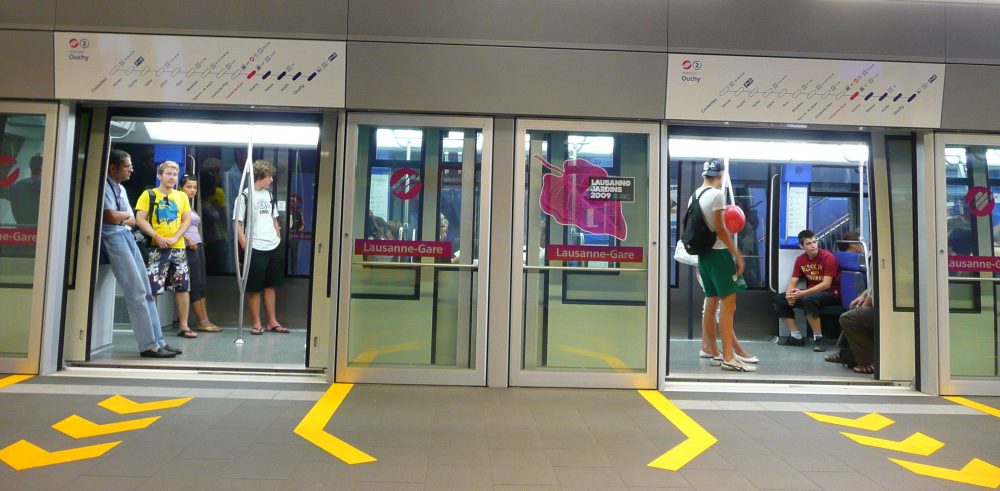Logic of Identification and Construction of a Narratee: A Linguistic Landscape Study of the Internef’s Hallway in the UNIL Campus
Mukuna Lola and Betti Paul
Abstract
This study investigates the realisation of event advertisement logics adopted in the posters located in the Internef building of the UNIL Campus, more specifically through specific language choices constructing an elitist multilingual academic narratee. Similar studies that have previously examined the subject in the field of Linguistic Landscape (LL) demonstrated that “identity formation in advertising tends to work through identification with narrators and narratees (O’Barr 1994)” (cited in Piller, 2006, p.3) and so consequently the advertisement construct the implied reader. Taking into consideration that identification strategies are part of the narratee construction, we thought that it should be therefore possible to establish a correspondence between the narratee and the linguistic landscape she or he occupies. To determine which specific narratee identities were constructed in the particular LL setting of higher education at the University of Lausanne, we conducted this research based on an image-based data collection in the Internef’s hallways in November 2018. The results show that all the narratees are indeed constructed by references to certain symbols, such as images or specific languages (English in our case) that are embedded in systems of value proper to the specific social fields of the Internef building which are the Faculty of Business and Economics and Faculty of Law.
- Introduction
This paper investigates the realisation of events advertisement logics which implies by specific language choices a logic of identification that, in the particular setting of an academic community, therefore constructs a peculiar narratee. The focus of this paper was chosen with the interest to explore the linguistic landscape of the specific area of the Internef’s hallway, located in the Internef building (Faculty of Business and Economics and Faculty of Law) of the University of Lausanne campus in Switzerland.
In her study, Piller discussed: “these [logic of] identity constructions [in] the discourse of (…) advertising” (2006 ; p.153). She investigated the construction of the implied reader in commercial and non-profit German advertisements. Her research showed that the construction of a narratee seeks the identification of potential buyers that share the same ideological or aesthetical values that the narratee. Taking into consideration that identification strategies are part of the narratee construction and that the Linguistic landscape is affected by them since “advertising tends to work through identification with narrators and narratees (O’Barr 1994, cited in Piller, 2006, p.3), we thought that it would be therefore possible to establish a correspondence between the narratee and the linguistic landscape s/he occupies.
The aim of this study is to shed light on the targeting strategies of commercial and non-commercial advertisement posters on the UNIL campus, and more precisely, in the Internef’s hallway. Using an image-based data corpus that was collected by taking pictures of displayed posters localised in the hallway area of the Internef’s building, we will analyse the construction and logics of events advertisements. Considering that: “[t]he body copy of the advertisement constructs the narratee” (Piller, 2006, p.154), we will investigate how language, in particular language creativity, creates a logic of identification, which takes part in the construction of a multilingual academic elitist narratee.
This paper is structured as follows: Firstly, we will consider a theoretical framework of what previous studies acknowledged about the linguistic landscape coupled with the discursive and semiotic creation of the narratee that is the focus of our research. Secondly, we will give a contextualization and justification of our choice. thirdly, we will explain what methodology was used to collect, select and investigate the data. Penultimately, we will expose the results and interpret them in a discussion. Finally, we will outline in the conclusion the main findings of our paper and also mention the limitations encountered as well as the possible future research orientations.
- Theoretical framework
Linguistic landscape (LL) commonly “refers to linguistic objects that mark the public space in a given territory.” (Ben-Rafael and al., 2006, p.8). But LL also participates in the narratee construction. In fact, “the field as the study of the symbolic construction of the public space” should be considered since “[i]ts linguistic markings may be analyzed according to languages utilized [for] their saliency and syntactic and semantic aspects.” (Ben-Rafael and al., 2006 ; pp.19-20).
Regarding the construction of the narratee, Piller, in her study of German multilingual advertising, also pointed out that: “identity formation in advertising tends to work through identification with narrators and narratees (O’Barr, 1994, cited in Piller, 2006, p.3) and that “representations of societal ideals, societal concerns can be used to call for identification” (Piller, 2006 ; p.156)
From these assumptions, we were able to hypothesise that each poster of our data could construct a specific kind of narratee and that it would possible for us to reconstruct this narratee by reading which type of identity it tries to construct through the logic of identification strategies and language strategies.
In our study, English is used to call for an economic identity construction, since our advertisement samples are related to the economic field or to attract identity profiles that value certain practices. That is to say, each field requires a specific linguistic capital. Indeed, when it comes to the structuration of LL, Bourdieu’s (1983) tradition sees social reality as consisting of power relations between categories of participants in given fields. (Ben-Rafael, Eliezer & Ben-Rafael, Miriam, 2015
Also as Kuppens interestingly pointed out “The meaning and/or humor of these ads can only be understood and appreciated if viewers are familiar with”(2009, p.118). If we define a community by a group of people that share similar symbolic representations such as moral values, language repertoires and social practices, we can thus establish that all the posters in the Internef’s hallway target a specific “community”. Furthermore, the implied reader constructed in these posters could therefore be identified by particular thematic and language that are associated with specific fields.
The present study is based on the aforementioned body of LL studies about the realisation of the narratee. previous research reveals that language is at the core of identification mechanism. Later in this study, our results will be analysed and discussed with these prior findings in mind.
- Contextualisation
For the purpose of this study, we will specifically focus on the Internef’s building on the University campus of Lausanne, Switzerland. Built between 1975 and 1977, the Internef building houses the Faculty of Law, Criminal Justice and Public administration, as well as the Faculty of Business and Economics (HEC Lausanne). Intended to receive 16000 students, it includes 5 audiences, numerous lecture rooms as well as the law and economics academic library. Our deliberate intention to have chosen the research context of Internef building, as a whole within a given academic setting, will hopefully outline a field that may justify a systematic study as it may constitute an interesting way of uncovering the possible correspondences between the constructed narratee of advertisements and the linguistic landscape he occupies.
As Arts students, that have most of their classes in the Anthropole (Arts, languages and philosophy building) building of the same campus, we are sometime given classes in some of the 5 audiences of the Internef building. We have noticed a remarkable difference in the LL that changes from one building to another. For example, Anthropole has more advertisment for musical events, art exhibitions, cultural events or philosophical conferences. And this difference led us question if the linguistic configuration of landscape (LL) reflects the faculties predominantly established in the buildings. Considering that: “Unlike nature, LL is however human-made and typically qualifies for Durkheim’s (1964/1895) definition of a ‘social fact’ as pertaining to social life, independent a priori from individual desires or inclinations. Hence, LL items appear to passers-by as ‘givens’ of the space” (Ben-Rafael, Eliezer & Ben-Rafael, Miriam, 2015, p.21). One could imagine that to reach an intended audience, the people who produce advertisement make assumptions about the values of the targeted audience along with their shared knowledge and languages competences. From that, we can affirm that discourse constructs identities.
We also chose this space because of our assumptions about social phenomena taking place in the Internef building. Indeed, we do assume that a causal link exists between the values carried by the faculty, and the configuration of its linguistic Landscape. Looking at the Faculty of Business and Economics official webpage, it states that HEC Lausanne: “has been training future executives and company directors to become the new leaders of the business world for over 100 years.”[1] and that: “[e]njoying a strong international reputation, the dynamic HEC Lausanne intends to continue its development as a leading public institution in integrated management and economic training at the European and global levels.”[2] These claims are to us symptomatic of the university LL setting because we can already see the inscription of the university in an international study and research networks and thus can assume that it will shape the representation of the narratee. In fact, we can see that part of one phenomenon in the Internef building is to heighten awareness of international questioning to student, which is reflected in our data base. Many times, concepts linked to the economic field (e.g.: globalised economy, the start-up nation, international law) are part of things that are international.
All of this led us to the following considerations. Firstly, it allows us to consider that every field consists a specific type of language and that each language value, according to the field, will be somehow mirrored in the LL. Secondly, this restricted and specific place of the Internef’s hallway will consequently involve a restricted and specific part of the populations (academic community). We will therefore certainly face a “higher, more complex and particular occurrences of field’s terminology and values that the Internef’s building hosts/carries.
- Methodology
The data analysed in this paper consists of five advertisement posters in the hallway that we collected by taking pictures of displayed posters localised in the hallway area of the Internef’s building back in November 2018. This commonly employed research technique geared toward eliciting a depiction of what type posters build the LL, offering a more likely representative portrayal of the everyday LL environment of the Internef’s building.
Bearing in mind that we wanted to observe how textual artefacts, such as posters, construct the narratee according to the values of the faculties, we thought that reducing the linguistic landscape to the hallway was a judicious choice for two reasons. The first one being that the hallway is a major stopping-off place which make those advertisements visible to everyone, and therefore must adopt in this mass some visual and linguistic strategies to stand out from the crowd in order to attract the targeted audience.
But this research based on an image-based data had to go through a selection. Indeed back in November 2018, we actually took ten pictures of multilingual manifestation on posters. We decided to keep five of them that permits us to only focus our research on posters that were directly linked to the faculties of the Internef building. Thus, our corpus is not entirely representative of all the different kinds of events that are proposed, since we selected some images and not others. Furthermore, because posters are substituted all the time, implying that there is a constant evolution of the LL of the Internef’s hallway.
The data was then classified and analysed. After having selected which of the ten pictures fitted the best our research, we decided to write down a list of steps to follow when we will be describing and analysing each picture; in order to be sure it would let us to answer our research question. This list prescribes how to analyse the proportion of words according to each language as well as the typography used (bold, small or big), and the kind of images used in the poster. It then defines how to interpret these informations, in order to reconstruct the targeted narratee (Piller, 2006 ; p.163).
- Results
Among the five posters we focused on, one is almost entirely in English with a small amount of French (appendix A, fig.3), one is the opposite (appendix A, fig.5) and three have a balanced proportion of each language (appendix A, fig.1-2-4). In proportion, French is more present in our corpus. However, in all of them, English is used to catch people’s attention walking by the posters. Figure 4 serves as a good example. Indeed, although French is dominant in quantity, English words have a bigger size for fond or are in bold. Furthermore, English can also be used to make a pun or a joke, such as “workchope” (Workshop and chope, fig.5). graph 1 which illustrates how English words are categorized according to their use, highlights this peculiar usage of English.
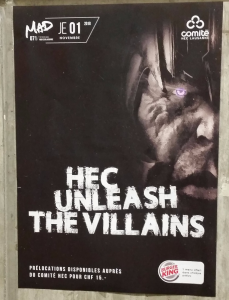
Figure 4 : English words are in bold, more visible, But there are more French words but in smaller font

Graph 1 : How English words are used (some can be in bold and in a title, or for pun mixed with french in a title, etc…)
French on the other hand was mainly used to provide practical information about the location, date and time of the events or procedure details for example. In the FIDAG award for example (fig.2), location and date of informational conference is written in French at the bottom of the poster. But mixing English and French to convey the message to university students is also a possibility. For example, the “Workchope” pun in fig.5, uses English as a base to create a bilingual pun composed of the word workshop and the French word chope, that refers to a mug of beer. The drawing of a man whose brain is connected to the beer by battery cable confirms the pun.
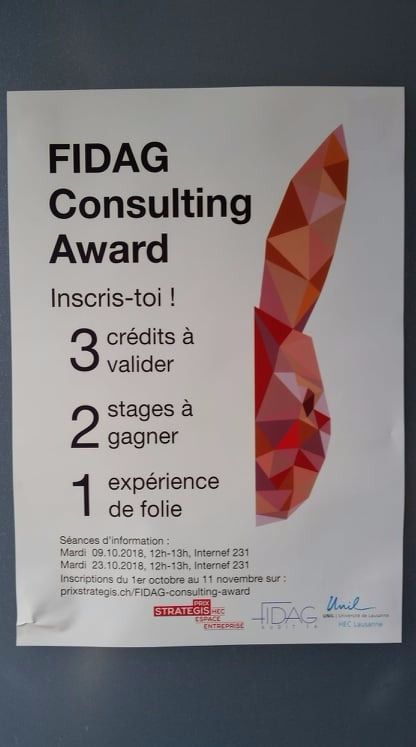
fig.2
Images behind the linguistic signs are also relevant to note. We can see the person depicted on the poster on data protection (fig.1), is probably a young man, whose face is hidden. The lights behind him are blurred. Both of these choices are linked to the subject of protection. The poster on circular economy (fig.3) uses a green circle and trees as symbols to suppose the trend of a more ecological economic development.
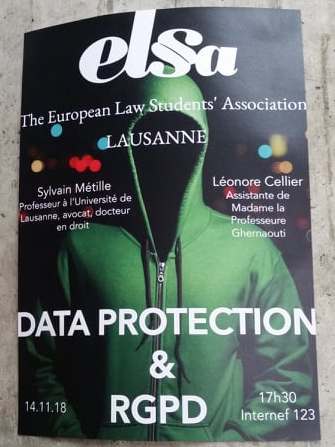
fig.3
We also noticed that, as we expected, some words were specifically related to certain social fields. Words such as “circular economy incubator” (fig.3) and “FIDAG” (fig.2) are related to the economical field. And words like “elsa”, “data protection” and “RGPD” (réglement général sur la protection des données, all from fig.1) are related to the juridical sphere. Finally, the word workshop, that is used to make the pun “workchope” (fig.5), is related to the educational/academic sphere.
We can thus observe that in this corpus of data, English can be either a more casual language to make jokes or catch attention, and also a language employed for the specific value it has in the field to which it refers. Alternatively, we can see that French is the official language, since it is used to communicate the informations that are necessary to the practical understanding of these advertisement (see graph.2 below).
- Discussion
The results of our study reflect the constructed character of linguistic landscapes (LL). Indeed, LL can be understood in terms of symbolic construction of the public space (Ben-Rafael and al. 2006, p.7). It gives a representation of which social group interact within, in our case, the Internef building of UNIL. Although is not perfectly representative of all types of possible occurrences, it reflects the plurality of targeted narratee (Piller ; 2006) that can be affiliated to specific faculties of the university. Among these faculties, we noticed the presence of three of them: HEC (economic and commercial school), Law school, and GSE (geosciences and environment). Our selection focus mainly on HEC-related posters.
Considering that: “From [a] presentation-of-self and primordialist perspectives, one would hypothesise that identity markers of communities would imprint themselves quite strongly on LL” (Ben-Rafael and al. 2006 ; p.10), identity markers of HEC and Law school can indeed be identified throughout the posters. For the HEC, economical lexicon and the high proportion of English-dominant posters underline the relation between the faculty and their identity markers in the LL. Law school related posters also uses specific lexicon such as “RGPD” and “elsa” (fig.1).
The outstanding importance of English as a lingua franca in cities (Ben-Rafael & Ben-Rafael 2015 ; p.35) can be seen in two different ways. Firstly, as explained earlier, its relation to international and economical networks makes it a valorized and authoritative language in the HEC and also in the Law school. Indeed, the concerns about international/European issues such as data protection (appendix A, fig.1) highlight the necessity of English to communicate between different countries about such topics. In another way, the importance of English is underlined by the possibilities it offers to make puns (fig.5), hence catch the attention of passers-by.
As we already underlined Ben-Rafael & al. ‘s claim earlier, LL is human-made, and qualifies for the Durkheim’s (1964/1895) concept of “social fact”, thus appearing to passers-by as “givens” of the space (2006 ; p.21). Social facts also have the particularity to impose themselves to the individuals. Hence, the values and symbols constructed or perpetuated through the posters participate to the construction of the social identities of students that interact with them. In the HEC-related posters, the value of English, as the economic language (appendix A, fig.2-3-4) influenced the choice of using it in these posters and also perpetuate its own legitimacy in the “field” (Bourdieu 1983, 1993, cited in Ben-Rafael and al. 2006, p.9). This specific value in the economical field is anchored in the HEC’s culture, therefore used in non-economical context, such as the figure 4 which promotes a faculty party in a nightclub and still uses English in bold in the title.
Piller (yesr) underlines the constructive effect of advertisement (in our case commercial posters for events) by stating that: “the social order is constantly being re-created by reference to model discourses such as advertising” (Corston-Oliver 1998, cited in Piller, 2006, p.156). In our study, these “discourses” (Foucault (1972:49), cited in Piller, 2006 ; p.155) are posters that use symbols linked to specific social fields. These references to . Piller’s concept of narrate helps to understand these strategies. He: “pointed out that the implicit reader (…) is constructed not only as bilingual in English [and French], but also as a [student] who [has specific] values” (Piller, 2006 ; p.163).
We identified in our corpus which narratee was constructed, and how. As an example, the poster about circular economy (appendix A, fig.3) constructs a narratee that values ecological concerns and recycling, but also economical and managerial interests, who desires to lead the construction of a start-up that binds these interests and values. Another example is the FIDAG consulting award poster (appendix A, fig.2). The low-poly hare and the countdown, linked to the “FIDAG” word referring to the economic sphere, constructs a narratee that is a competitive HEC student, interested in entrepreneurialism, start-ups and managerialism. An “ambitious and adventurous”[3] student that is not afraid of risks, ready to run to the top and who desires to win an internship in financial consulting. All these narratees are constructed by references to certain symbols, such as images or specific languages (English in our case), that are embedded in systems of value proper to social fields.
Finally, in all our posters we also found considerable use of the official language (in our case French). On the one hand, it may express à la Bourdieu (Ben-Rafael and al. 2006), the power of institutions aspiring to assert the validity in LL of societal symbols. But it would however simultaneously express the actors ‘collective allegiance to these all-societal identity symbols (Ben-Rafael & al. 2015 ; p.34). On the other hand, a hypothesis could be that some information is necessary to be understood, and thus are written in the official language.
- Conclusion
The aim of this study was to investigate how language, in particular language creativity, adopts a logic of identification, which takes part in the construction of a multilingual academic narratee.
The main findings of this study confirm the presumptions we have made concerning the language creativity involved in the construction of a multilingual academic elitist narratee: translanguaging, alternation (e.g. RGDP & Data protection), mixing English and French to convey the message to university students (e.g. work-chope), puns that require a good knowledge of the language used, all of these are just a few examples of linguistic creativity at UNIL that is most likely not to be found in the same degree in other places in Lausanne (and especially in non-commercial signs). Still, the adopted pattern seems to be redundant: the use of English and writing systems are in brands when practical information is given in French, the official language, in these signs.
We have seen that an undeniable elitism is implied by the subtlety of language (such as puns) and the context of specific language use which indirectly only construct a higher educated narratee. As Eliezer Ben-Rafael & al. accurately mentioned “LL analysis allows us to point out patterns representing different ways in which people, groups, associations, institutions and governmental agencies cope with the game of symbols within a complex reality.” (2006; p.27) Hence, all narratees of this study are constructed by references to certain symbols, such as images, specific language (English in our case) and terminology that are embedded in systems of value proper to social fields.
As mentioned previously, some potential limitations in this study included the ones of our analysing data since we excluded some posters that did not fit our precise research question and because we restricted the linguistic landscape to only the hallway of the Internef building. We should therefore extend these observations on a longer period of time, and also see if our assumptions are applicable to the entire building.
Hence, after our first attempt to analyse the various discursive and symbolic manifestations of the narratee construction in the Internef’s hallway, possible future research orientations could be to figure out if different articulations and configurations can be observable in other departments of the UNIL campus and if so, consider if each LL is representative of its buildings’ faculties that the UNIL campus houses.
In conclusion, we found that our hypothesis of a particular logic of identification, presenting a specific and undeniable elitist language strategy linked to the faculty’s values which simultaneously correlate with the configuration of its linguistic Landscape, that constructs a higher educated narratee, was correct.
Appendices
Appendix A :

Figure 1 : law school poster for a conference

Figure 2 : HEC poster for consulting award
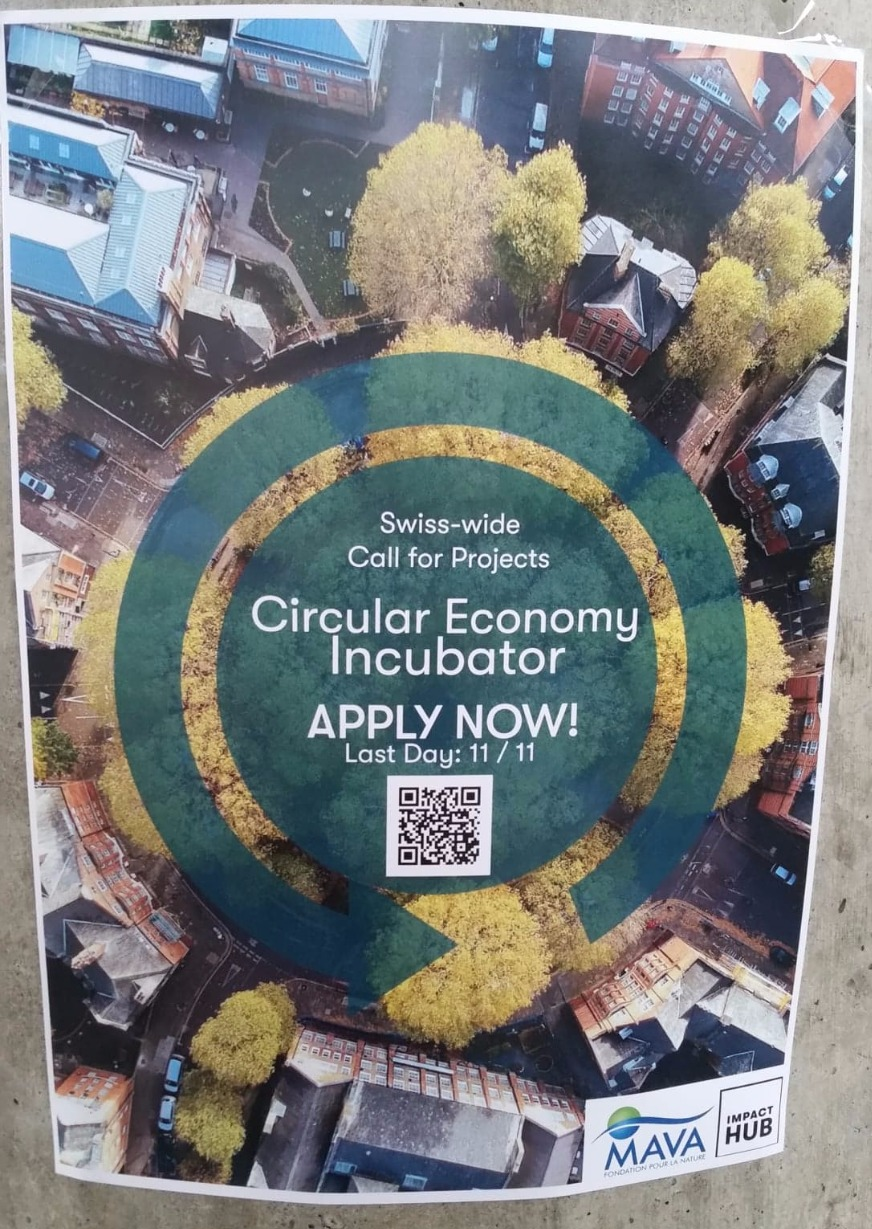
Figure 3 : HEC poster for startup incubation
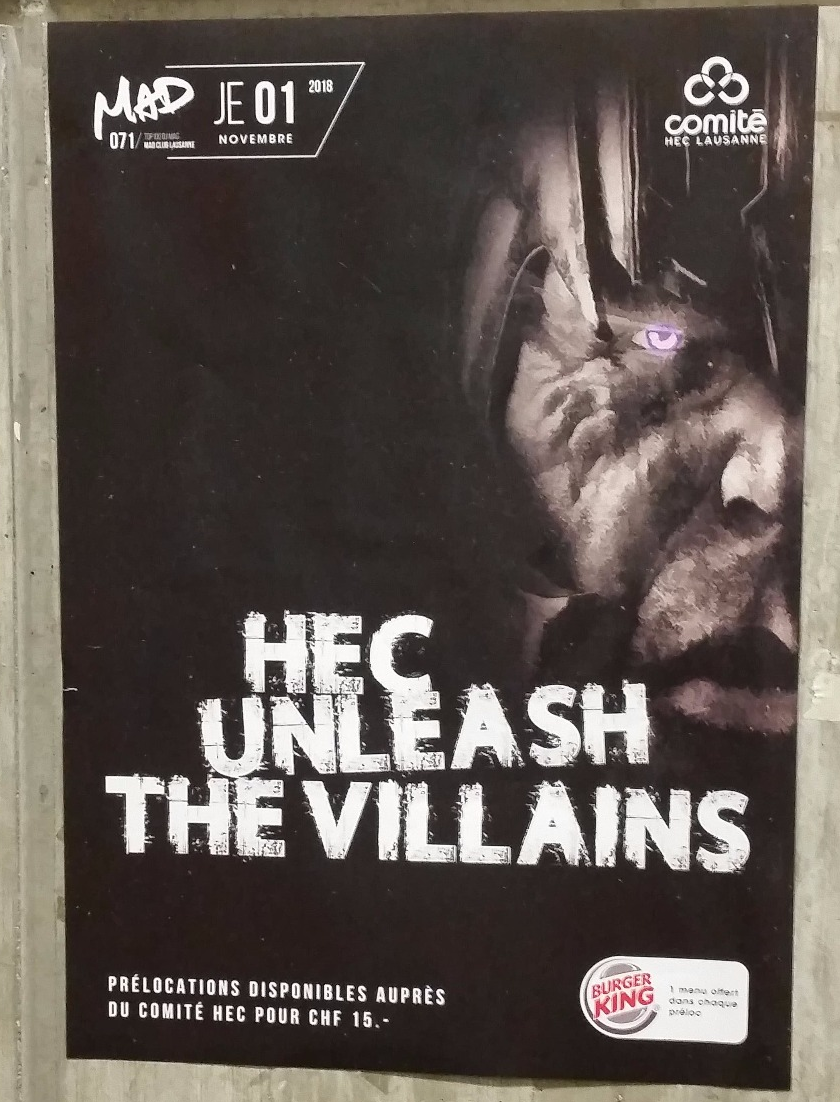
Figure 4 : HEC poster for student party
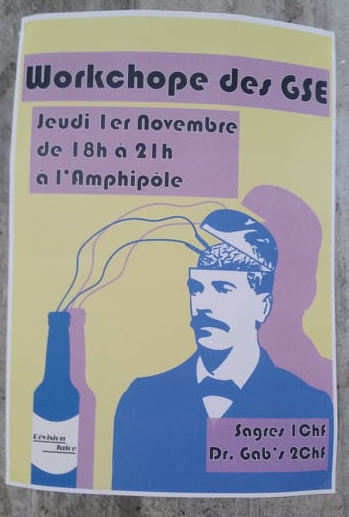
Figure 5 : GSE poster for after-class party
Appendix B:

Graphic 1 : How English words are used (some can be in bold and in a title, or for pun in a title, etc…)
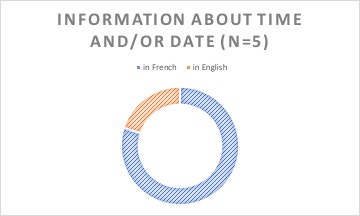
Graphic 2 : Which language is used for practical information
References
Eliezer Ben-Rafael , Elana Shohamy , Muhammad Hasan Amara
& Nira Trumper-Hecht (2006) Linguistic Landscape as Symbolic Construction of the Public Space: The Case of Israel, International Journal of Multilingualism, 3:1, 7-30.
Ben-Rafael, Eliezer & Ben-Rafael, Miriam, 2015 “Linguistic landscapes in an era of multiple globalizations” Linguistic Landscape, 1:1, 19 – 37.
Kuppens AN H., 2009. “English in Advertising: Generic Intertextuality in a Globalizing Media Environment” Applied Linguistics, 31:1, 115–135.
Piller, Ingrid, 2006. “Identity constructions in multilingual advertising ” Language in Society, 30:2, 153–186.
[1] https://www.unil.ch/hec/en/home/menuinst/a-propos/carrieres.html
[2] https://www.unil.ch/hec/about
[3] used terms on the FIDAG website to describe students that participate to this competition. https://prixstrategis.ch/FIDAG-consulting-award/
